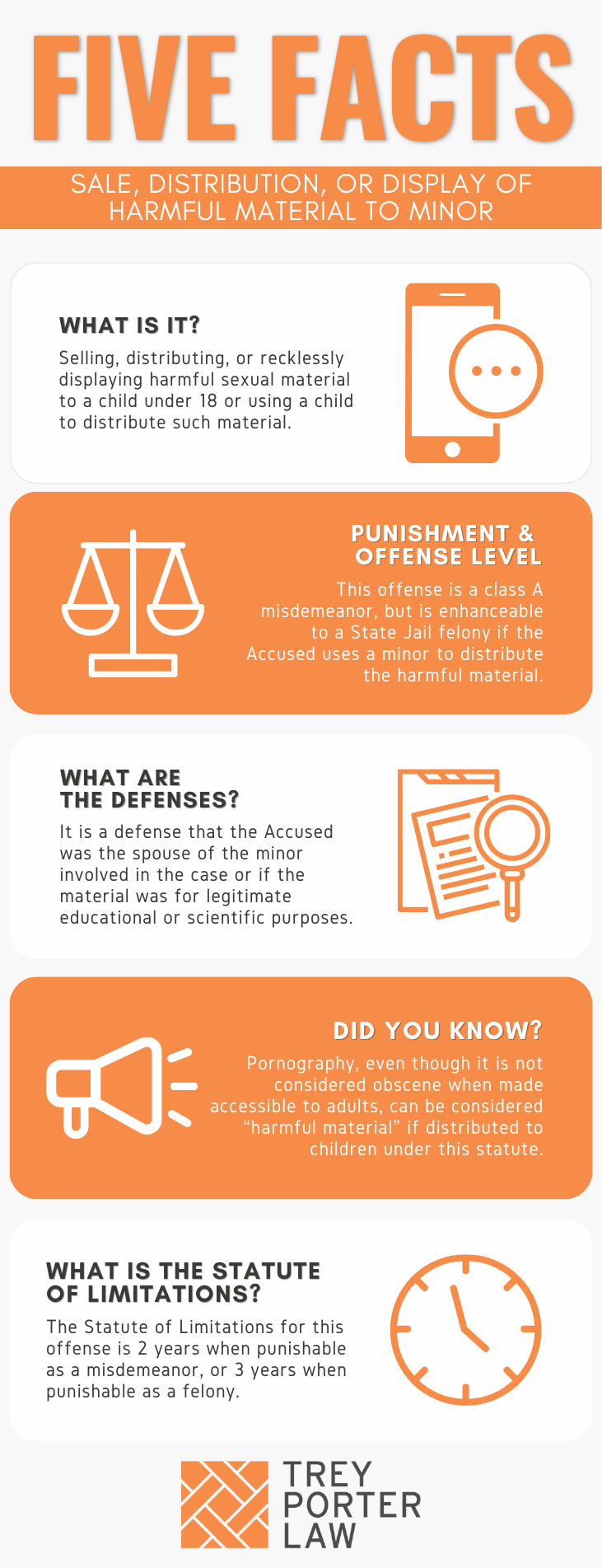WHAT IS SALE, DISTRIBUTION, OR DISPLAY OF HARMFUL MATERIAL TO MINOR IN TEXAS?
Texas criminalizes selling, distributing, or recklessly displaying “harmful material” to a child under 18 years of age. A person also violates this law by hiring or using a minor to sell, distribute, or display harmful material to other minors.
- What is “harmful material”? Texas law deems material “harmful” if its dominant theme, as a whole: (1) appeals to the prurient interest of a minor, in sex, nudity, or excretion; (2) is patently offensive to the prevailing community standards with respect to what is suitable for minors; and (3) is utterly without redeeming social value for minors. Pornography, even though it is not considered obscene when made accessible to adults, can be considered “harmful material” if distributed to children.
WHAT IS THE SALE, DISTRIBUTION, OR DISPLAY OF HARMFUL MATERIAL TO MINOR LAW IN TEXAS?
Tex. Penal Code § 43.24. SALE, DISTRIBUTION, OR DISPLAY OF HARMFUL MATERIAL TO MINOR.
(b) A person commits an offense if, knowing that the material is harmful:
(1) and knowing the person is a minor, he sells, distributes, exhibits, or possesses for sale, distribution, or exhibition to a minor harmful material;
(2) he displays harmful material and is reckless about whether a minor is present who will be offended or alarmed by the display; or
(3) he hires, employs, or uses a minor to do or accomplish or assist in doing or accomplishing any of the acts prohibited in Subsection (b)(1) or (b)(2).
(c) It is an affirmative defense to prosecution under this section that the sale, distribution, or exhibition was by a person having scientific, educational, governmental, or other similar justification.
(c-1) It is a defense to prosecution under this section that the actor was the spouse of the minor at the time of the offense.
(d) An offense under this section is a Class A misdemeanor unless it is committed under Subsection (b)(3) in which event it is a felony of the third degree.
WHAT IS THE PENALTY CLASS FOR SALE, DISTRIBUTION, OR DISPLAY OF HARMFUL MATERIAL TO MINOR IN TEXAS?
Sale, distribution, or display of harmful material to a minor is a Class A misdemeanor, punishable by up to one year in county jail. If, however, a person uses a minor to commit the offense, it is a third degree felony, punishable by two to ten years in prison.
WHAT IS THE PUNISHMENT RANGE FOR SALE, DISTRIBUTION, OR DISPLAY OF HARMFUL MATERIAL TO MINOR IN TEXAS?
The punishment range for the Class A misdemeanor offense of selling, distributing, or displaying harmful material to a minor is a maximum possible jail sentence of one year, and up to a $4,000 fine. If charged as a third degree felony, it carries between two and ten years in prison, and a maximum fine of $10,000.
WHAT ARE THE PENALTIES FOR SALE, DISTRIBUTION, OR DISPLAY OF HARMFUL MATERIAL TO MINOR IN TEXAS?
A person charged with sale, distribution, or display of harmful material to a minor may be eligible for probation after a conviction, or deferred adjudication without a conviction. The maximum period of community supervision for a Class A misdemeanor is two years, and ten years for a third degree felony.
WHAT ARE THE DEFENSES TO SALE, DISTRIBUTION, OR DISPLAY OF HARMFUL MATERIAL TO MINOR IN TEXAS?
The statute authorizes two defenses. The first is an affirmative defense available if the accused shows the sale, distribution, or exhibition was for scientific, educational, governmental, or other similar justification. For example, a health and sexual education teacher must be permitted to show minor students explicit photographs for educational purposes. The second statutory defense is available if the accused was married to the minor at the time of the offense.
- What if the accused did not know a minor saw the “harmful material”? The statute only requires the State to prove a person was reckless about whether a minor was present who will be offended or alarmed by the harmful material displayed. Even if a person does not know a child saw the visual material, if they displayed it somewhere in a reckless manner, that is sufficient to sustain a conviction.In Barton v. State, a defendant was charged for displaying harmful material to a minor after viewing porn on a library computer while children were nearby. The children saw the pornographic videos playing on the computer the defendant was using. The defendant testified he did not notice the children, but knew children were present at the library. The appellate court affirmed his conviction, holding the statute only requires a person to be reckless about whether a minor is present, and does not actually require a minor to be present or see the material.
WHAT IS THE STATUTE OF LIMITATIONS FOR SALE, DISTRIBUTION, OR DISPLAY OF HARMFUL MATERIAL TO MINOR IN TEXAS?
The limitation period for sale, distribution, or display of harmful material to a minor categorized as a Class A misdemeanor is two years. If the offense constitutes a third degree felony, the limitation period is three years.
SALE, DISTRIBUTION, OR DISPLAY OF HARMFUL MATERIAL TO MINOR IN TEXAS
Sale, distribution, or display of harmful material to a minor prohibits showing or disseminating sexually explicit, patently offensive visual representations or literature to anyone under 18 years of age.
TEXAS SALE, DISTRIBUTION, OR DISPLAY OF HARMFUL MATERIAL TO A MINOR COURT CASES
The case law regarding sale, distribution, or display of harmful material to a minor in Texas speaks to the statute’s constitutional validity.
- In State v. Stone, a special agent posed as a 13-year-old girl while chatting online with the defendant, who sent three sexually explicit photos of himself exposing his genitals. Police compiled enough probable cause to execute a search of his home and computer, and found child pornography. The search warrant affidavit was based on the belief the defendant committed attempted display of harmful material to a minor, because the police knew the special agent was not actually a minor. The appellate court determined Section 43.24 is a constitutionally permissible variable of obscenity laws.












